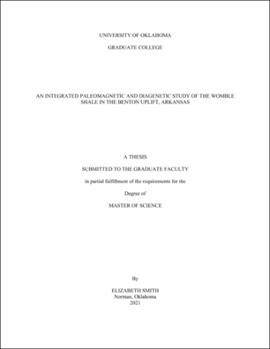| dc.description.abstract | The objective of this project is to conduct an integrated paleomagnetic and diagenetic study of the Ordovician Womble Shale in Mt. Ida, Arkansas, in order to test if diagenetic events can be identified and dated with petrographic and paleomagnetic techniques. Significant hydrothermal alteration has been identified and dated in western Arkansas and the paleomagnetic analysis will test if a magnetization of similar age that was caused by hydrothermal fluids can be identified. Samples were collected from a Womble Shale outcrop, located west of Mt. Ida, Arkansas, which are composed of shale alternating with calcareous sandstone lenses that contain numerous veins filled with quartz and calcite. The samples were characterized based on thin section petrography and scanning electron microscopy (SEM), and a paragenetic sequence was determined. In addition to acquiring paleomagnetic data to determine the timing, anisotropy of magnetic susceptibility (AMS) data was collected to examine the petrofabrics and identify alteration.
The calcareous sandstones contain a complicated diagenetic history which includes precipitation of authigenic phases during multiple fluid events and deformation. The calcite and quartz veins, both vertical and horizontal, are interpreted to be hydrothermal and syntectonic in origin. Hydrothermal minerals including xenotime, monazite, biotite, and sphalerite are identified within veins and in the matrix as are hydrocarbons. Stylolites containing mics are present in the matrix and in larger veins. Fibrous clay bands composed predominantly of muscovite and illite with hematite staining are also present in the matrix. Diagenesis within the Womble Shale indicates a unit influenced by hydrothermal fluids, most likely in several episodes, low-grade metamorphism, and deformation.
AMS data suggests that the petrofabric of the Womble Shale is a composite fabric with influences from burial, tectonic, and diagenetic processes. Alternating field (AF) demagnetization identified a post tilting thermoviscous remanent magnetization (TVRM) held in magnetite with a Late Mississippian pole. The demagnetization paths are curved which suggest contamination with a modern viscous magnetization and the pole age is not considered reliable. A magnetic component removed during thermal demagnetization after AF treatment reveals a post tilting characteristic remnant magnetization (ChRM) held in hematite with a Late Pennsylvanian pole position. The ChRM is interpreted as a thermochemical remnant magnetization (TCRM) caused by precipitation of hematite during hydrothermal alteration. The petrographic and paleomagnetic results suggest the acquisition of a syntectonic hematite magnetization in the Late Pennsylvanian probably coincided with hydrothermal alteration. This contrasts with other studies which report post orogenic hydrothermal activity in the Ouachitas (e.g., Shelton et al., 1986). | en_US |
